Debasing Wall Street's new debasement trade idea
The debasement trade is a catchy and plausible idea, but there’s no sign that markets are alarmed, says Cris Sholto Heaton


Sometimes an idea is so catchy that it doesn’t matter whether it’s true. The “debasement trade” – the claim that investors are starting to price in a severe surge in inflation that will erode the value of money – is a good example. We see it everywhere in headlines at the moment. Yet it’s impossible to see much evidence in markets. To begin with, we have to agree on what is being debased. The US dollar is the favoured target. However, if you look at the dollar versus other major currencies, there is no sign of this happening. Yes, it is down since the start of the year, and still seems more likely to fall than rise against over the next few years if foreign sentiment towards US assets continues to cool. But it has been stable since June. We’re not even seeing weakness now, let alone debasement.
Maybe the debasement is in all fiat currencies, so they won’t fall against each other because they are all equally bad. Instead, they will weaken against real assets. The surge in gold and other precious metals seems to support this. Yet stocks are also doing well, even though they typically struggle in high inflation (they often rise during hyperinflation, but that is a different scenario). More likely, traders are latching onto gold because it’s been going up: record flows into gold exchange-traded funds (ETFs) support this idea. A few months ago, I noted that we were not seeing these flows – now it has changed.
Bond yields and the debasement trade
If markets were genuinely becoming much more worried about inflation, we’d expect to see it in bond yields. While many yields have risen this year – especially longer-term government bonds – this always felt more like markets were pricing long-term uncertainty about government policy and finances, not specifically forecasting inflation. It continues to look that way.
MoneyWeek
Subscribe to MoneyWeek today and get your first six magazine issues absolutely FREE

Sign up to Money Morning
Don't miss the latest investment and personal finances news, market analysis, plus money-saving tips with our free twice-daily newsletter
Don't miss the latest investment and personal finances news, market analysis, plus money-saving tips with our free twice-daily newsletter

Yields have mostly come down in the last few weeks. Even more significantly, inflation breakevens – the difference between the yields on a conventional bond and an inflation-linked one of the same maturity – are not rising (see above). Breakevens are not a good forecast of inflation, but if markets are functioning normally, they will express fear of inflation through nominal yields that rise faster than inflation-linked ones and thus through widening breakevens.
Of course, we may well see high inflation if governments run large deficits while forcing central banks to cut rates and control yields. But it’s wrong to claim the market’s watchdogs are sounding the alarm. They are clearly not – yet.
What to do if inflation surges will be on the agenda at Turmoil, Tariffs and Trump 2.0, the MoneyWeek Wealth Summit, on Friday, 7 November in London. Our morning keynote speaker, Dylan Grice, will discuss the difficulties of investing in this “high-signal” environment, while our multi-asset panel of Charlie Morris (ByteTree), Charlotte Yonge (Troy), Frank Ducomble (RIT) and Jasmine Yeo (Ruffer) will share ideas on how to hedge the risks. See moneyweekwealthsummit.co.uk for details.
This article was first published in MoneyWeek's magazine. Enjoy exclusive early access to news, opinion and analysis from our team of financial experts with a MoneyWeek subscription.
Get the latest financial news, insights and expert analysis from our award-winning MoneyWeek team, to help you understand what really matters when it comes to your finances.
Cris Sholto Heaton is an investment analyst and writer who has been contributing to MoneyWeek since 2006 and was managing editor of the magazine between 2016 and 2018. He is especially interested in international investing, believing many investors still focus too much on their home markets and that it pays to take advantage of all the opportunities the world offers. He often writes about Asian equities, international income and global asset allocation.
Cris began his career in financial services consultancy at PwC and Lane Clark & Peacock, before an abrupt change of direction into oil, gas and energy at Petroleum Economist and Platts and subsequently into investment research and writing. In addition to his articles for MoneyWeek, he also works with a number of asset managers, consultancies and financial information providers.
He holds the Chartered Financial Analyst designation and the Investment Management Certificate, as well as degrees in finance and mathematics. He has also studied acting, film-making and photography, and strongly suspects that an awareness of what makes a compelling story is just as important for understanding markets as any amount of qualifications.
-
 Where can I get pension advice?
Where can I get pension advice?A popular directory of pension advice professionals has closed, leaving those seeking help with their retirement unsure of where to go. We look at the options
-
 The investing mistakes not to make: MoneyWeek Talks
The investing mistakes not to make: MoneyWeek TalksPodcast MoneyWeek's digital editor speaks to Andrew Craig, founder of Plain English Finance, about why passive investing isn't always the only option for good investors
-
 Stock markets have a mountain to climb: opt for resilience, growth and value
Stock markets have a mountain to climb: opt for resilience, growth and valueOpinion Julian Wheeler, partner and US equity specialist, Shard Capital, highlights three US stocks where he would put his money
-
 The steady rise of stablecoins
The steady rise of stablecoinsInnovations in cryptocurrency have created stablecoins, a new form of money. Trump is an enthusiastic supporter, but its benefits are not yet clear
-
 SRT Marine Systems: A leader in marine technology
SRT Marine Systems: A leader in marine technologySRT Marine Systems is thriving and has a bulging order book, says Dr Michael Tubbs
-
 Goodwin: A superlative British manufacturer to buy now
Goodwin: A superlative British manufacturer to buy nowVeteran engineering group Goodwin has created a new profit engine. But following its tremendous run, can investors still afford the shares?
-
 A change in leadership: Is US stock market exceptionalism over?
A change in leadership: Is US stock market exceptionalism over?US stocks trailed the rest of the world in 2025. Is this a sign that a long-overdue shift is underway?
-
 A reckoning is coming for unnecessary investment trusts
A reckoning is coming for unnecessary investment trustsInvestment trusts that don’t use their structural advantages will find it increasingly hard to survive, says Rupert Hargreaves
-
 Modern Monetary Theory and the return of magical thinking
Modern Monetary Theory and the return of magical thinkingThe Modern Monetary Theory is back in fashion again. How worried should we be?
-
 Metals and AI power emerging markets
Metals and AI power emerging marketsThis year’s big emerging market winners have tended to offer exposure to one of 2025’s two winning trends – AI-focused tech and the global metals rally
